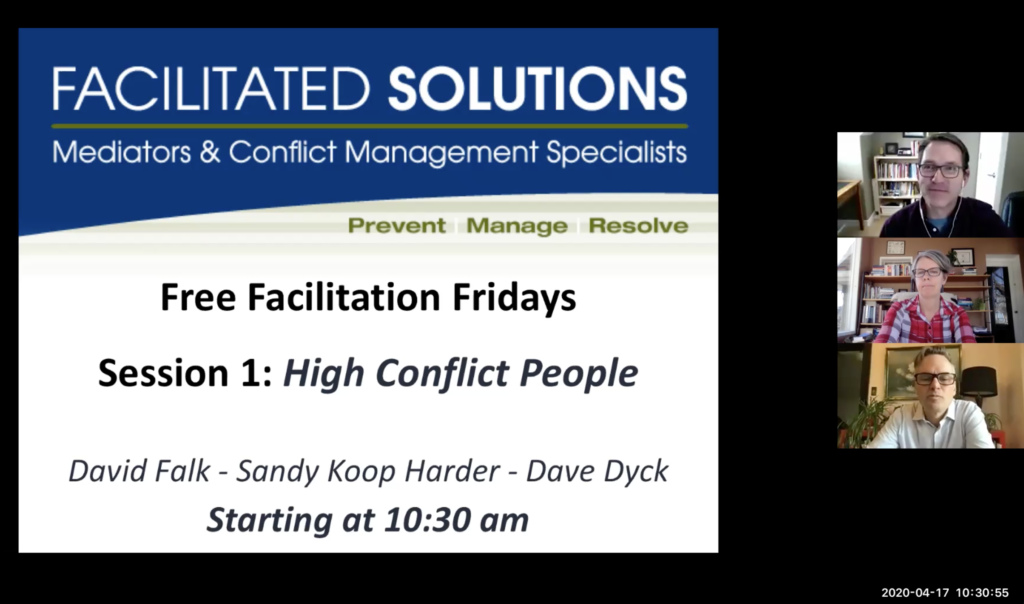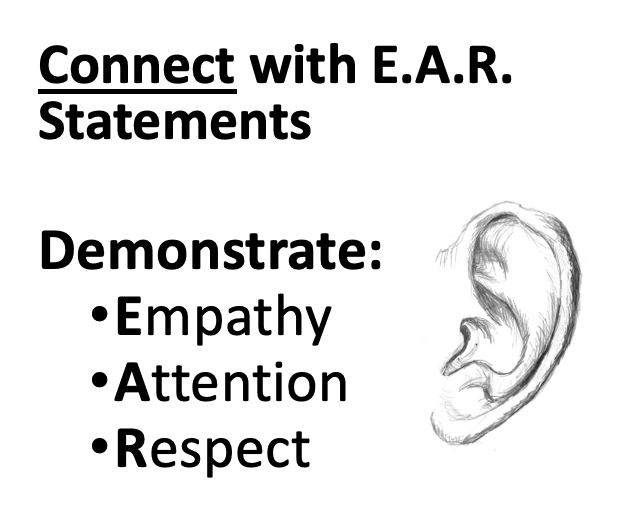So… we are well underway on our new project: Facilitation Fridays! Thanks to everyone who has joined us for these event so far.
For those of you who aren’t aware, the FS partners (Dave, David and I) recently decided that one way we can “give back” at this time of pandemic quarantine would be to freely share our collective wisdom on conflict management topics with our clients and community. There’s never a shortage of conflict in life, and that has never been truer than when we are experiencing increased stress, isolation, extra pressures from all kinds of places and very close proximity with a very few people!
After deciding to shift our public training event on Managing High Conflict People to an online, free 90 minute session, the idea of Free Facilitation Fridays was born. Each week on Fridays at 10:30 AM CDT we will be sharing about the concepts, models and tools that have influenced our work at FS over the years. We will specifically be grounding those concepts in our current context with the hopes that you will find some helpful tips and ideas to support your interpersonal and group challenges (at work and at home) both now, in the middle of quarantine, and beyond.
In our first session on April 17th, as I already mentioned, we shared about “High Conflict People”. And we promised that we would share our resources with you. We also promised to provide some further information in response to some of the questions that you raised in the chat box but we didn’t have time to get to. Unfortunately, the session recording that we had hoped to also provide turned out to be completely unusable ? (we’re all still learning about online tools!). In any event, we hope you find this information helpful.

Here is the pdf of the slides we used in our presentation. And here is a link to an article that I wrote after my first introduction to the idea of High Conflict People that overviews much of the key content of our conversation.
OK… so now to get to some of your comments and questions.
Would EAR statements be used as an alternative to the Four F’s principle?
An EAR statement is an active listening tool that is made up of three key, specific components: empathy, attention and respect.

The “Rule of the Four F’s” is simply this: Feelings First, Facts Follow. We often use this “rule” as a guiding principle for active listening skills, understanding that, often, capturing/exploring the emotional content of what the person is saying is prerequisite to understanding/exploring the facts of the matter. In other words, once the feelings have been acknowledged, the facts often follow naturally. Active listening, and paraphrasing in particular, functions to both acknowledge the speaker, helping them feel heard, and to elicit additional information – both emotional and factual.
In the context of “high conflict” behaviours, we are actually trying to contain the speaker rather than invite them to share more. EAR statements – where we demonstrate (very concisely) empathy, attention and respect – serve to acknowledge the speakers concerns and limit their propensity to go on and on.
So, to answer the question, yes. EAR statements do function as a replacement for the Four F’s rule. With high conflict behaviours, we are not inviting more sharing about feelings, we are actually attempting to limit more sharing about feelings…
How might you get people unstuck from the past when they are obsessed?
This is a great question. And the answer is deceivingly simple – and yet hard to implement.
With “high conflict’ people, it’s important to actively steer them away from talking about the past. Focusing your interactions and your questions on the present and the future, and keeping the conversation there, will go a long way to helping the person shift. It can help to be very transparent about this right up front.
Start with and EAR statement and try saying something like, “I can see that these past events are still causing you an enormous amount of pain and stress and I certainly respect that, because you don’t have resolution on those things, it’s very unsettling. I am also noticing that when we talk about events from the past that we don’t seem to be moving the conversation forward. Earlier you stated that one of your goals is to come up with a plan about X… so in order for us to get there, we are going to need to focus our conversation on what we can do right now and in the future… and park the conversation about the past for now. So, let’s talk about what you can do today that will help you to move toward X…“
Then, your task becomes keeping the conversation contained and very focused when things veer back into the past (because they likely will!).
This process and discussion seemed quite focused on interpersonal but how do you support or train others in the team?
You’ve essentially answered your own question. Training, I think, is simply the only way you can equip people to get better at managing these kinds of difficult interactions. Training coupled with good ol’ practice. The opportunity to practice in a safe, controlled setting is really critical to skill development – so, yes, the dreaded role play. Many people hate role plays, but we’ve not yet found a better way to help equip and support this kind of critical capacity building.
Is there a danger in always giving in?
While it may feel like engaging in a conversation with a high conflict person is “giving in”, the models and tools we are discussing in this session are actually intended to do just the opposite: to set boundaries and limit behaviours (which is the antithesis of accommodating or acquiescing).
Engaging in this highly structured way does require a robust set of assertiveness skills – to keep the “high conflict” person focused on the present and future. It can be exhausting. It really is a skill set – that you can develop over time and with practice.
Thanks to everyone for your thoughtful questions and engagement. These events have been a lot of fun for us to pull together and share.
Join us for our next Facilitation Friday event. And spread the word. The more the merrier!
Be well, friends.
Sandy
